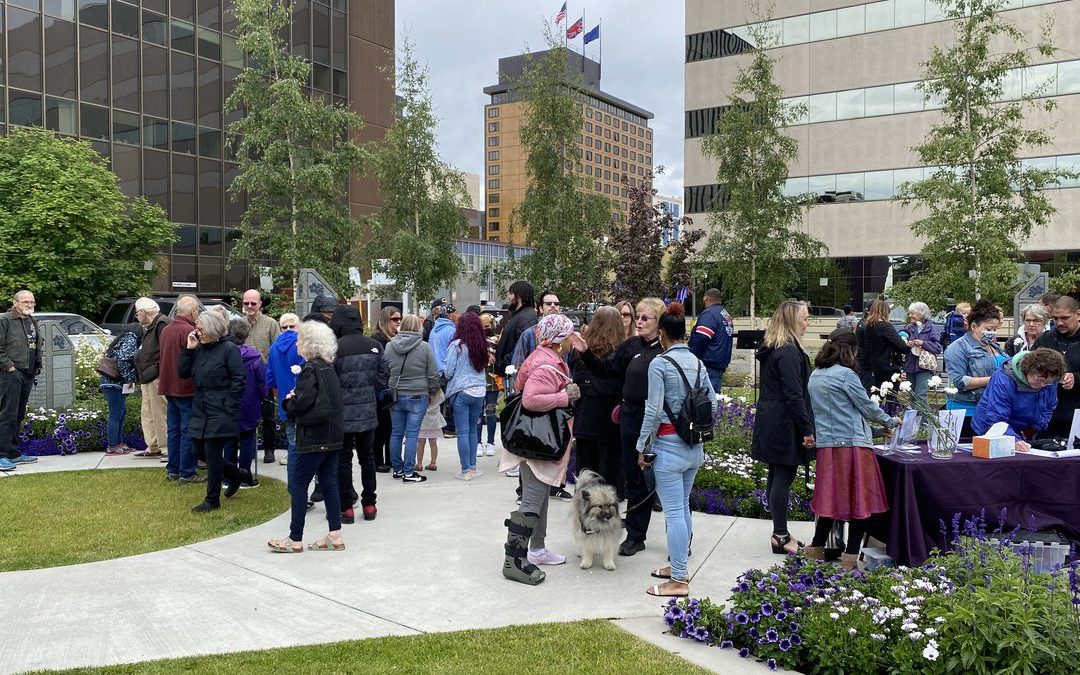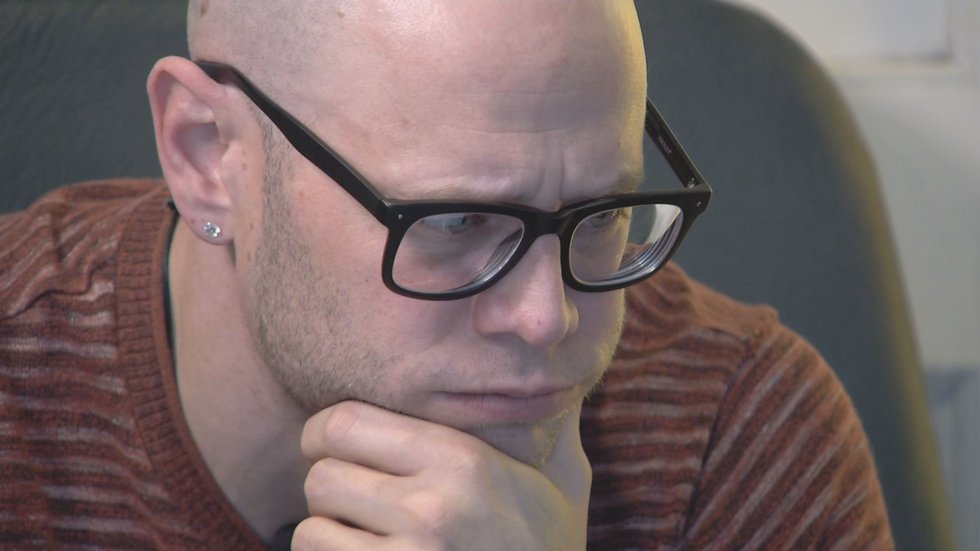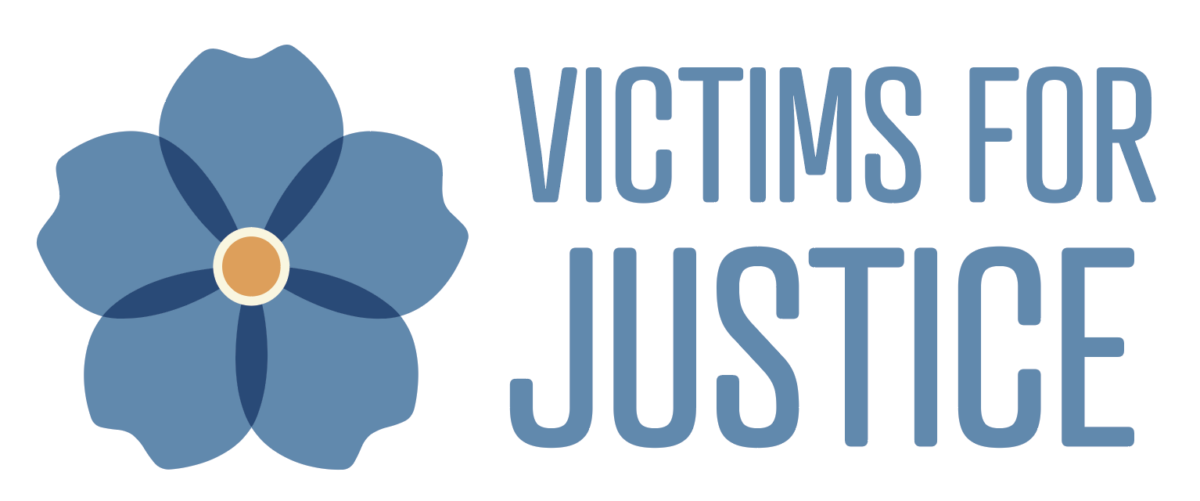
by Victims For Justice | Jan 31, 2022 | News Clips
Originally published in Alaska’s News Source
ANCHORAGE, Alaska (KTUU) -Anchorage’s annual Homicide Memorial Ceremony brings an opportunity to raise awareness and express grief while honoring Alaskans whose lives have been cut short due to senseless acts of violence.
“This memorial not only serves as a remembrance of victims of homicide, but it also serves as hope for the future,” said Sean Case, a captain with the Anchorage Police Department who spoke at the event.
Each pillar at Hostetler Park is engraved with the names of victims of homicide in Alaska. 29 names were added Saturday by the group Victims for Justice.
“This is something we all need to be thinking about,” said Victoria Shanklin, executive director of Victims for Justice. “This is something that is impacting all of us, and we need to understand how to best support those who have lost a loved one.”
Among the names added to the memorial Saturday is Chase Bowerson, whose life was taken by a
senseless crime in January. He was just 26 years old.
“This is the type of loss that, from my perspective, your wound doesn’t heal,” said Jeff Trent, Bowerson’s father. “It’s been six months since we lost Chase, and just the other day, I felt like this wound to me is just as raw and fresh as it ever was.”
Trent says Chase was a good guy, adding that he was young and ambitious, possessing many good qualities.
“After his passing, I learned even more about him and some of the things he was doing, like charities, and just all these stories came out,” said Trent. “People (were) sharing instances where he’d help people that were less fortunate or needed help.”
Trent is among several others who gathered at the Homicide Memorial ceremony who are also remembering and grieving the loss of their loved one.
“Every life that we lose, it’s not just one individual or one family that’s impacted — it is our entire community, and we feel that impact every single time,” said Shanklin.
The pain extends beyond the families directly impacted. Shanklin says eight names a year added to the memorial used to be the average, but in recent years, she says unfortunately, it’s far exceeded that amount and that there are now over 450 names, and that the memorial site at Hostetler Park is running out of space.
“The whole society needs to act like this is a real problem that we have, and we all need to band together to keep it from happening to others,” said Trent.
Copyright 2021 KTUU. All rights reserved.

by Victims For Justice | Jan 31, 2022 | News Clips
Originally published in Alaska’s News Source
ANCHORAGE, Alaska (KTUU) – On an overcast, cloudy day back in October 2018, Kyle Andrews committed a crime that would alter his life forever and garner statewide coverage about one of the worst days of his life.
He says he had been smoking meth and heroin inside a halfway house when he started having issues with another man. Andrews said he felt paranoid and craved something to help him calm down and sleep.
What happened next impacted Andrews, and his freedom, and today it’s a major barrier for him finding a job.
News reports at the time say Andrews was the subject of a suspicious person call after someone spotted him acting erratically. He was found near the roundabouts at Dowling Road and the Seward Highway where he ran into a construction zone, got into a construction vehicle, and then fled from police.
Officers chased Andrews and blocked him in with patrol cars near 64th Avenue and Ashwood Street, near Polaris K-12 School. The school was put into stay-put mode.
Andrews then drove the vehicle into a shallow marsh, ignored officers’ commands, and only after being tased was stopped and arrested on a warrant for escape. Andrews was additionally charged with vehicle theft, criminal mischief and resisting arrest. Along the path of his escape, muddy tire tracks could be seen on the sidewalk by the school and orange police crime tape lined the area.
That was the latest in a string of arrests that started back in August 2018.
Because of the escape and the school lockdown, news organizations wrote a story about the arrest with a photo provided by police. In the picture Andrew smiled intensely at the camera. His face was swollen and puffy.
Andrews says he had been using drugs or alcohol, in some form or another, since 2003 until 2019.
Then, in November of last year, Andrews emailed Alaska’s News Source.
“My name is Kyle Andrews,” his email read. “I was featured in the news several years ago and have since been to treatment and made outstanding progress. I am asking you for help. I have been looking for a job since I got clean and as far as I know, I am hitting a wall because whenever you google me ‘Kyle Andrews Anchorage’ … well, see for yourself. It’s amazing what one bad day in the news can do for someone. I would appreciate an opportunity to offer you a chance to visit the men’s group I run on Wednesday night and take a look at the content of the meeting, participate and write a story. Please let me know if you are interested.”
Updating old news stories has been a growing focus of newsrooms across the country. “The Right to be Forgotten” is an initiative that pushes for people to have the right to have information about themselves removed from internet searches or other online sources, and has been implemented in places like the Cleveland Plain Dealer news organization, with funding from the Google GNI Innovation Challenge. It’s become a social justice issue, partly because some crime stories can be clouded in bias.
“Many have turned their lives around and are trying to move forward, but our stories get in the way, blocking job hunts or relationships,” the Cleveland Plain Dealer’s website says.
Andrews met Alaska’s News Source in a coffee shop where he was handing out flyers for his start-up catering business. Today he looks healthy; he works out and stays in shape.
“When I was using it was a like distraction, right? And my anxiety kind of took over and it became a compulsion, and so now, I just have a lot of time and I don’t enjoy wasting my time,” he said.
Andrews, like many formerly imprisoned Alaskans, faces huge obstacles finding a job and good housing.
According to the National Survey on Drug Use and Health, Alaska was ranked as one of the top 10 states for illicit drug use in 2010-11. According to the survey, 13.65% of Alaska residents reported using illicit drugs in the past month at the time it was taken. The national average was 8.82%.
Additionally, Megan Edge of the ACLU of Alaska said Alaska’s high rate of recidivism is about 66%. Alaska defines recidivism as returning to custody within three years of release.
There are also societal barriers, which Andrews faces, that impede stability and reintegrating to society.
“Anybody with a felony on their record is going to face a lot more barriers,” Edge said.
One of those barriers is news coverage that vividly details a person’s crime and remains on the internet forever.
According to Anchorage nonprofit Victims for Justice, the conversation about life after prison should also include the victim.
“If someone is truly on a path to recovery and has the ability to be a meaningful participant in society again, then it’s important that there are those paths involved, and particularly for someone who may not be a violent offender where there isn’t concern in that area,” said Victoria Shanklin, executive director for Victims For Justice.
Victims for Justice is an organization that specializes in services to victims of violent crime outside of domestic violence and sexual assault.
“It’s really important that those who are impacted by the crime have a voice throughout the process and have a way to process what’s going on and heal,” Shanklin said. “Sometimes that’s more possible than others and it really just depends on the individual, it depends on the crime, and again in this case it appears he was not a violent offender. While acts are violating, and that has an impact on the victims, there is a difference there.”
Edge says that about 96% of the prison population will be released at some point over their lives.
“When we’re thinking about justice, a lot of the time what we’re really seeking is like, a level of accountability,” Edge said. “And so, does accountability look like punishment, or does accountability look like rehabilitating somebody so they become a productive member of our society?”
Andrews said his biggest struggle is finding someone who will give him a job.
“I have a masters in business and years of professional experience and can’t find a job that will hire me and pay me what I’m worth,” Andrews wrote via email. “If I didn’t have my criminal history I would be able to make 60-100k depending on where I live. It’s been a major struggle.”
Edge said there are national movements to stop prospective employers from asking people if they have been convicted of a felony.
Alaska’s News Source told Edge that some people say a person like Andrews who committed crimes should have to live with the consequences.
“I think about, like, what if I was defined for the rest of my life by my worst mistake, where would I be?” Edge said. “And I go back to this idea of accountability. So Kyle has been held accountable for what he has done, and what do we want as a community? Do we want to put him in a concrete warehouse with four white walls to stare at for the rest of his life, where we pay about $150 a day for him to just sort of exist, or do we want Kyle to be back in the community contributing to our economy, contributing to our community in a positive way?”
Andrews said it’s unfortunate his actions impacted others.
“But what I can do is I can talk about those things and help other people realize it can be better,” Andrews said.
Copyright 2022 KTUU. All rights reserved.
by Paula Dobbyn | Nov 17, 2021
Alaska women with mental health challenges, developmental disabilities, Alzheimer’s disease, chronic alcohol use disorder, and other brain disorders are much more likely than women without these conditions to experience intimate partner and sexual violence, according to new research.
The findings come from the Alaska Victimization Survey 2020, conducted by the University of Alaska Anchorage Justice Center with funding from the Council on Domestic Violence and Sexual Assault.
The survey of 2,100 respondents found extremely high rates of violence against Alaska women overall. For example, nearly half of all Alaska women surveyed said they have experienced intimate partner violence in their lifetimes (47.8 percent) and four in 10 have suffered sexual violence (40.3 percent). Nearly six in 10 Alaska women (57.6 percent) have experienced intimate partner violence, sexual violence or both during their lifetimes.
But having a mental health, substance misuse or developmental disability make Alaska women much more vulnerable to these violent crimes. Researchers found that of the Alaska women surveyed who said they experienced intimate partner violence, sexual violence or both, half would be considered beneficiaries of the Alaska Mental Health Trust
The Trust was established in 1956 to benefit Alaskans with mental illness, development disabilities, Alzheimer’s disease, chronic alcohol or drug addiction, dementia, and traumatic brain injuries.
The Alaska Victimization Survey also found that Alaska women who were Trust beneficiaries were twice as likely to have experienced four for more Adverse Childhood Experiences than women who were non-beneficiaries. Adverse childhood experiences include verbal and emotional abuse, mental illness in the home, substance abuse in the home, separation or divorce, sexual or physical abuse, being a witness to domestic violence, and having a family member incarcerated.
by Paula Dobbyn | Oct 12, 2021 | Blog, News
A new statewide survey reveals a staggeringly high percentage of Alaska women face victimization in their homes, relationships and communities, figures that are likely underreported and on the rise.
According to the 2020 Alaska Victimization Survey, conducted by the University of Alaska Anchorage (UAA) Justice Center and the Council on Domestic Violence and Sexual Assault, nearly 60% of Alaska women surveyed reported having experienced intimate partner violence, sexual violence, or both during their lifetime.
That’s a 14.7% increase from a similar study conducted in 2015.
Some 2,100 women over 18 participated in the survey. It found that 48 out of 100 Alaska women reported intimate partner violence; 41 out of 100 Alaska women experienced sexual violence; and 58 out of 100 experienced either of these types of violence over the course of their lifetime.
“This survey helps give voice to the hundreds of victims of violence across our diverse state,” said L. Diane Casto, executive director of the Alaska Council on Domestic Violence and Sexual Assault.
The data shines a light on the scope of the problem, increases public awareness and should help policymakers better align and direct resources to the areas that need them the most, she said.
The lead researcher on the project was UAA’s Dr. Ingrid Johnson.
The numbers were collected via household survey of randomly selected adult women in Alaska. Participants are asked a series of behaviorally specific questions to determine their experiences with lifetime and past year intimate partner violence, sexual violence, and stalking, according to the researchers.
The high abuse statistics likely reflect only a fraction of what Alaska women actually experience.
Numerous studies, including national victimization surveys, have found the majority of individuals who experience rape/sexual assault and nearly half of those who experience intimate partner violence do not report their victimization to police.
Researchers say the best way to gather data on crime victimization is to ask a large number of individuals whether or not they have been victimized, and make estimates based on those data.
Read the study here.



Recent Comments